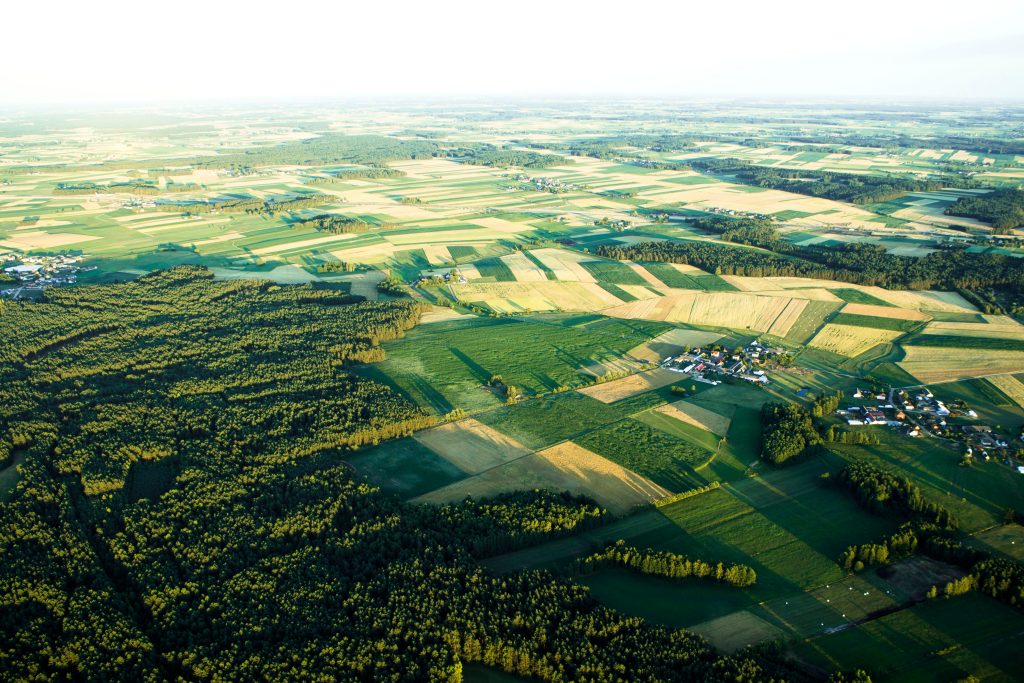This year’s harvest has concluded. It’s a good time to review current practices and consider what we can do to improve soil health, increase drought resistance, and manage water more sustainably, as well as how to prepare for the next harvest. We discuss this with Patryk Kokociński, a farmer who irrigates his fields naturally, utilizing landscape retention water. Thanks to his efforts, the “Życie na Pola!” Association for the Protection of Mid-Field Landscape was also established.
Patryk, winner of the 2024 Farmer of the Year award and a member of the expert group for the updated drought effects counteracting plan (uDECP), which serves as an advisory board for this process, shares his experiences. He discusses what sparked his interest in retention and the measures he is implementing on his own farm. He explains what is currently lacking in Poland and what is crucial in counteracting the effects of drought. He also explains the practical benefits of retention and how he responded to this year’s drought. And what should you do after the harvest is over? You can read all about it in our interview.
1. How did your water retention journey begin? What prompted you to implement such solutions?
Our water retention journey began with a drought. It’s a seemingly obvious answer – when we face a problem, it’s natural to seek a solution. 2018 was a key year for us, when we recorded only 380 (sic!) mm of rainfall throughout the year on our farm. This is clearly insufficient to make a living from farming, and only a step away from even surviving. On our dairy farm, a consistent, quality yield year after year is paramount. Running business “as usual” was no longer possible. Based on years of observation, it became clear that water, or rather its periodic shortages, is the main factor limiting the productivity of our business. And we decided to focus on improving this aspect. This proved to be the right move, as 2019 brought another extreme drought to our region, with annual rainfall totals falling below 350 mm. Thanks to water retention, we survived this drought unscathed, and we are now confident that our vision of water-conscious agriculture is working.
2. What specific measures do you take on your farm to retain water in the landscape?
First and foremost, we don’t treat retention as a single measure that, once implemented, solves the water deficit problem. We know there’s no such solution. We implement many small practices on our farm to improve the water retention capacity of the landscape we work in. This happens on many levels. We believe that retention is cheapest and most effective where water falls, which in our case is in the field. We prioritize the organic matter content of our soils, as it is the primary reservoir of water in the soil. We have adapted our cultivation methods (we’ve abandoned the plow) to minimize the mineralization of this matter and the loss of organic carbon as much as possible. We also prioritize its supply – we use the vast majority of organic fertilizers (slurry and manure). Every year, almost the entire farm is sown with cover crop mixtures, which protect the soil from wind erosion and nutrient leaching after the main crop is harvested. They also provide significant amounts of nitrogen and organic matter.
But soil is only the first layer of retention, because sooner or later, water from the fields will drain and end up in the drainage system. Therefore, another important element of the retention system was the modernization of the ditches and drainage facilities. Working with the Water Company and local farmers, we rebuilt and repaired the water-holding devices in the ditches to retain water longer, raising the water table and improving access for crops.
Furthermore, we also consider the surrounding landscape from the perspective of landscape water retention. We are restoring all elements of the agrocenoses, which farmers sometimes derogatorily call “unproductive areas.” That means field margins, roadsides, buffer zones along ditches, mid-field shelterbelts, and shrubbery. While these may seem unproductive at first glance, what’s most important from our perspective is that they are areas with active water retention, which can positively impact the landscape’s moisture levels, and therefore our workplace.
3. What changes in soil condition and water availability have you observed after implementing these measures? Have you noticed an increase in crop drought resistance?
Absolutely. We’ve observed a number of positive changes – from increased organic matter content, through the formation of larger soil aggregates, to improved soil aeration and more earthworms! This is precisely the soil life we’re gaining by implementing regenerative agriculture practices. And what follows? Greater drought resistance, of course. Each additional percent of organic matter in the soil has the potential to store almost 200 cubic meters of water per hectare. Our average organic matter content in soils is 3%. Not much, but nationwide, soil fertility doesn’t even reach 2%. Worse still, our soils are constantly depleting. Consequently, they are increasingly susceptible to drought. However, these solutions are effective not only in drought conditions. The proper soil structure and fertility also significantly improve the absorption of heavy rainfall, which is increasingly frequent in our region. As a result, we now see virtually no ponding or water erosion in our fields – something that was a significant problem just a few years ago.
4. This year, despite the rainfall, we are also experiencing drought in Poland. Have you felt it more than in previous years? What were its effects on agriculture?
This year is exceptional. Exceptionally difficult, it’s worth noting. First, there was a very severe drought at the beginning of the growing season (February-May), which caused serious losses, especially in winter cereal crops. Then came harvest time, and it turns out we’re having a very rainy and cold summer, which completely blocked the harvest in many regions. Unfortunately, such “lurched harvests” have a very negative impact on the quality of the crops. This year, Poland also experienced an exceptionally high number of local extreme events, including torrential rainfall and hailstorms, which also affected our farm. However, these phenomena are in line with climatologists’ predictions, the potential occurrence of which was discussed years ago. Today, we have to face them, more or less prepared. The spring drought barely affected us at all, thanks to the water reserves stored in the drainage network. And when it ended in late June, it started raining – what a blessing!
5. In your opinion, what is the importance of water retention for agriculture – now and in the future? Do you think landscape water retention can be a key element in combating water deficits in agriculture? Is it really worth investing in such solutions – and are they truly effective?
The ironic thing is that while farming in the 21st century, we have access to everything. Whatever our heart desires is at our fingertips. The latest technologies and the best varieties. Today, we have robots that sow, weed, and milk cows. And yet, we’ve forgotten the most important thing: water. Water is the main yield-forming factor, and no one will ever change that. We stopped paying attention to it because we’ve become so comfortable in the belief that water has always been, is, and will always be. Recent years, however, have shown something completely different. Agricultural drought occurs in Poland every year, occurring at different times and in different regions, but it has ceased to be an extreme phenomenon; it has become a new reality. Every year, agriculture loses over 6 billion PLN due to drought (according to calculations by the Polish Economic Institute). Today, it’s no longer the number of hectares that determines a farm’s strength, but its yield potential. This, in turn, is directly related to organic matter content and, consequently, drought resistance. The ability to manage stormwater on a farm will sooner or later become a key factor in a farmer’s economic stability. Therefore, yes, it’s worth investing in retention – especially in landscape systems. It’s an effective and accessible solution that helps mitigate the effects of drought.
6. Do you collaborate with other farmers or institutions on water management? What does this collaboration involve and what practical benefits does it offer?
Of course! After all, the law in Poland is structured in such a way that to retain water in ditches that extend beyond our land boundaries, we require the written consent of the landowners adjacent to those ditches.
In my case, this collaboration was not the result of obligation, but of a conscious partnership and a strategy developed over years to support the drought resilience of our area. We collaborate with local farmers, with whom we jointly decide where, when, and how to retain water in ditches to maximize its use, but also to ensure no one is harmed (e.g., by flooding).
We also collaborate with Agricultural Advisory Centers across Poland, with whom we organize training for farmers and agricultural advisors on water management in agricultural landscapes.
Our collaboration with the local Water Company has also been invaluable. After years of difficult negotiations, we finally began rebuilding the drainage network so that it no longer serves solely drainage purposes. Together, we are restoring the drainage system to its dual nature of irrigation and drainage, maintaining ditches in good condition while also repairing and constructing new damming facilities.
What have we achieved in practice? Over 1,500 hectares of agricultural land, from which no drop of water is draining through the drainage network without our knowledge. This is a huge advantage, and it would be foolish not to use it.
7. How do you prepare your fields after harvest? What do you think is important to do during this transitional period to maximize soil protection from water loss and erosion?
First and foremost, we minimize the period of time fields are exposed after harvest – the soil shouldn’t remain uncovered for long. Sun, wind, and rain are all factors that cause nutrient and organic matter loss. After harvesting grains, silage corn, and sugar beets, we apply cover crop mixtures on all plots where possible, which protect the soil from weather conditions. They also provide additional nutrients and organic matter. Our goal is for fields to remain green year-round.
8. What do farmers need most today to effectively combat drought?
They definitely need an understanding of the gravity of the situation resulting from deepening water shortages, and the often-emphasized “agricultural solidarity,” but this time in retaining water in the agricultural landscape. I see from my own experience that if it weren’t for neighborly cooperation, the consent expressed by neighboring farmers, or just a simple, human understanding of the need to retain water in the drainage network, I wouldn’t have done anything. Very often, when I meet farmers visiting our farms, I hear that they would like to implement such measures themselves, but that they are unable to obtain consent from their neighbors. It’s very common for one or two farmers in river valley (dominated by permanent grasslands – meadows – where we have excellent conditions for water retention) to come along and clear their meadows, plant corn, and then refuse to even consider storing water because the corn will be too wet.
Furthermore, we need education. Climate education, education on the role of green infrastructure in agricultural landscapes. Without this, we will encounter a situation every year where, after significant rainfall (see this summer), the topic of drought, or rather, strategies for counteracting it, is sidelined. After all, it rained. Everyone has forgotten that we had one of the driest springs on record, and many crops suffered.
So I invite everyone to familiarize themselves with the “Stop Drought! Start Retention!” project. Their website contains information on actions everyone can take to improve the water situation in our country.

 PL
PL

